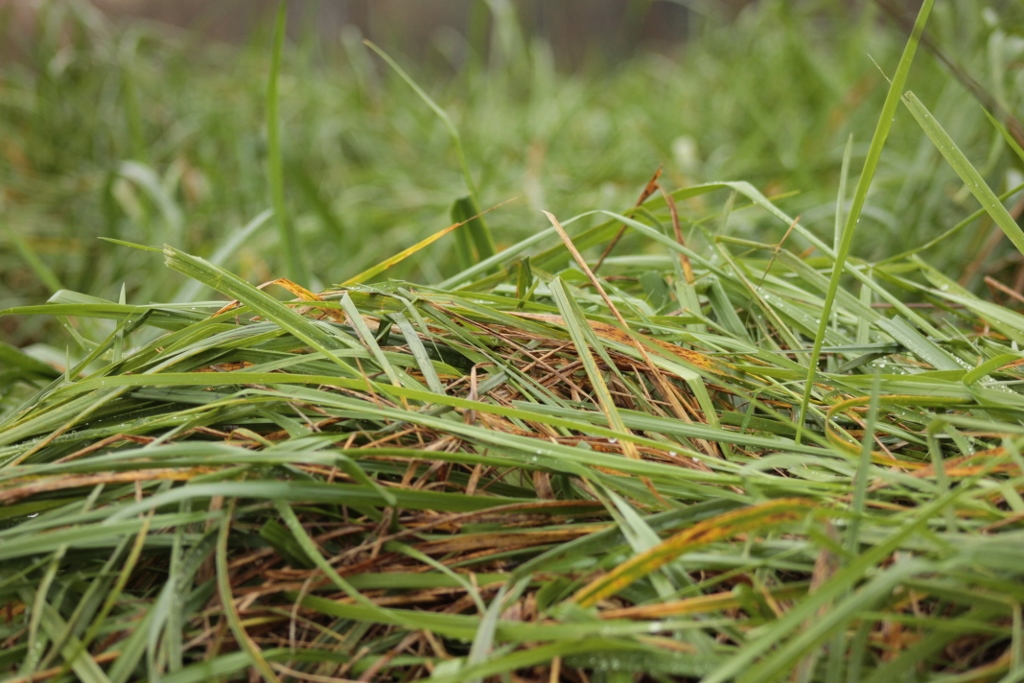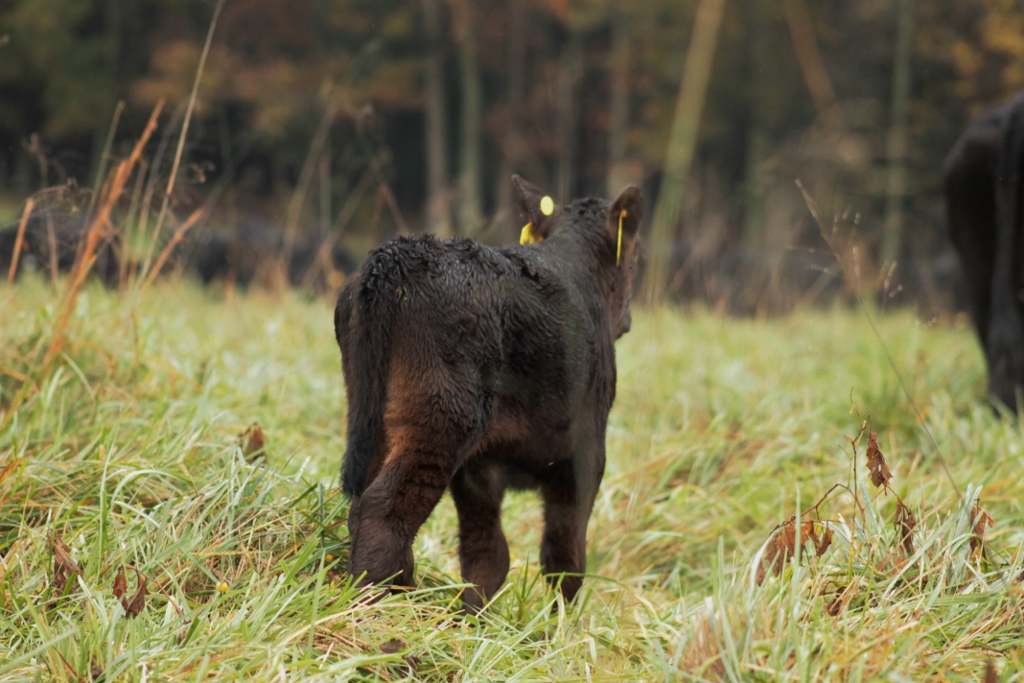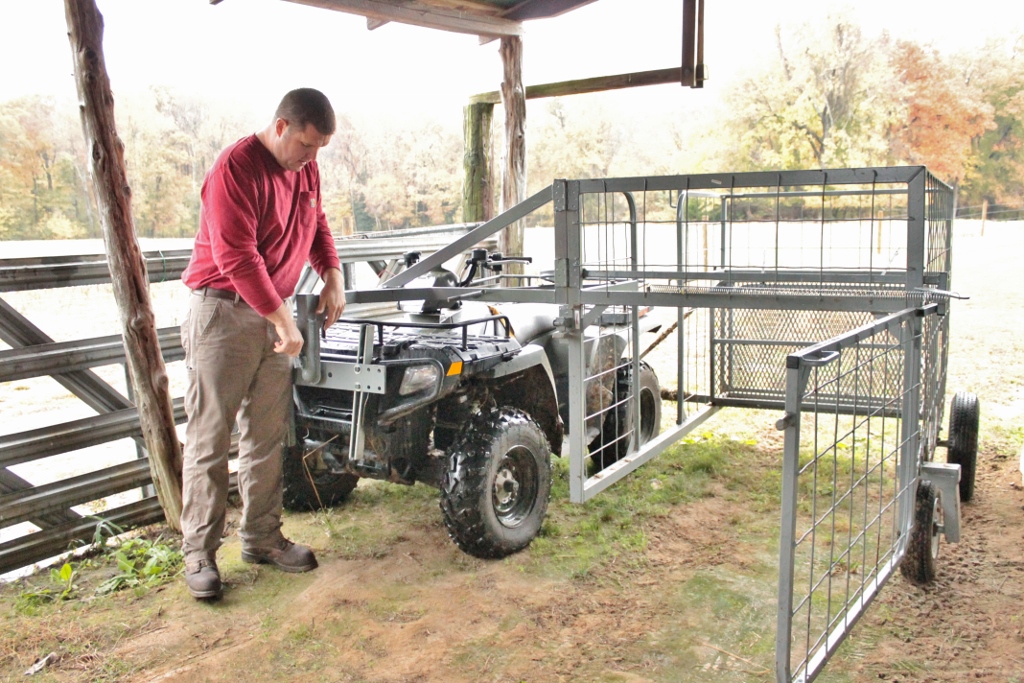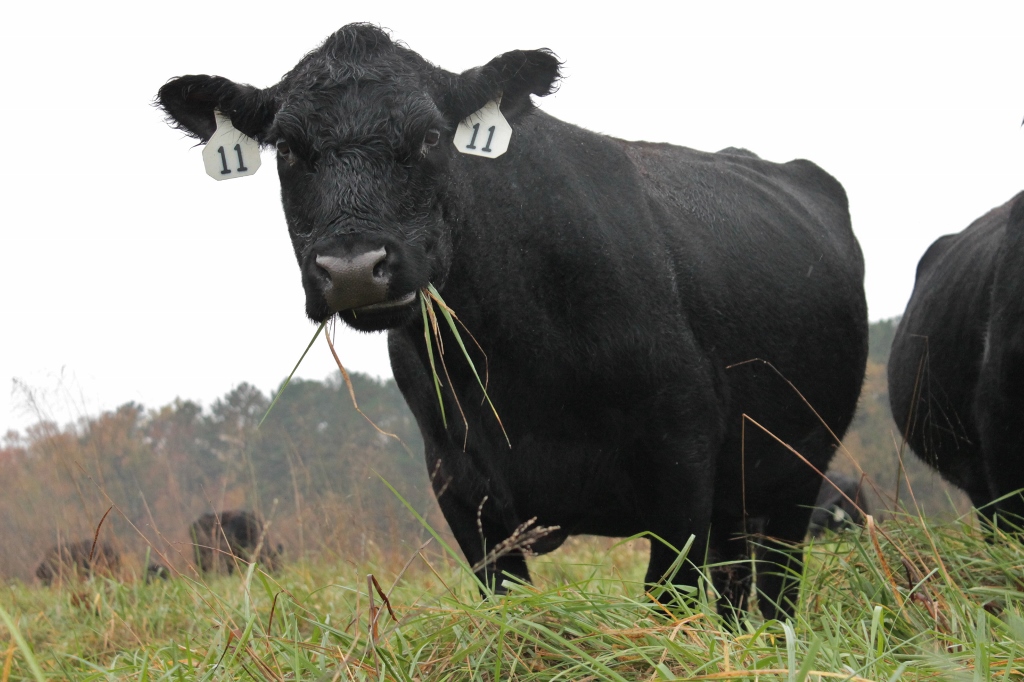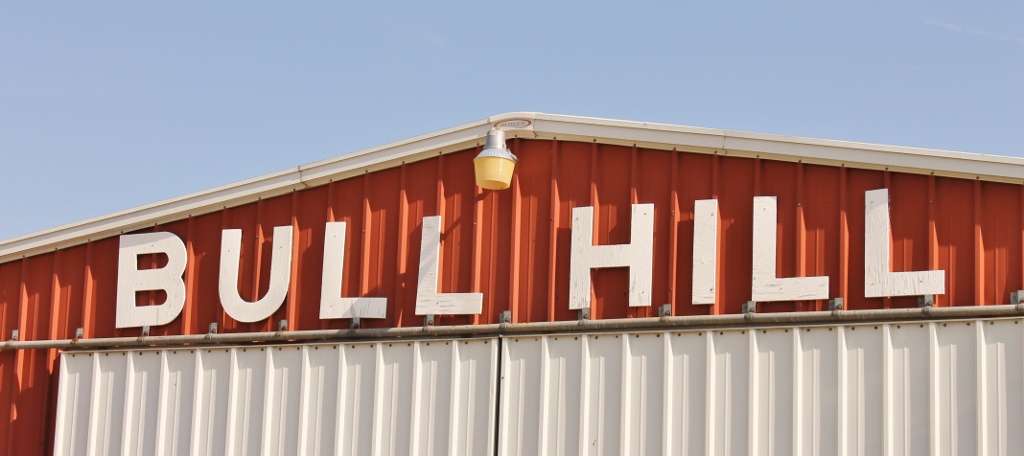Bobby grew up in Dinwiddie County and has been cultivating an affinity for farming since his childhood. Like many young farmers who start their own operations, he built his vision from scratch starting with just one Hereford cow in 2004. Today, alongside his wife Alicia, he manages a high-quality commercial herd of about sixty cow-calf pairs on his farm in McKenney.
What sets Bobby apart from some of his peers, young and old, is his exceptional ability to manage the forages on his farm. When Bobby started the farm, much of the acreage that is now in pasture was unimproved or full of unproductive broomstraw. On the land he owns and rents, Bobby made improvements, built fences, and applied nutrients to fix fertility issues in the soil, using management to shift pasture composition in favor of tall fescue for his animals to graze.
Establishing grass can be challenging, but keeping a pasture healthy is a battle of its own. Livestock owners who overstock animals, run out of pasture, or allow too many animals to continuously graze one area can wear out their fields in no time. To combat this, many cattle producers including Bobby enact “controlled grazing” plans to maximize forage production, grazing efficiency, and plant longevity. Bobby subdivides his pastures into small sections with temporary fencing and rotates his herd to a new section of grass every few days in accordance with the speed at which the cows utilize the space given to them. “There’s no formula to tell you how often to move them,” he says. “How often I move them depends on the lay of the land, water sources, and other factors. You put something up, get a feel for how long it lasts, and go from there.”
Bobby rotates the herd to new ground frequently to allow grazed sections to recover. “I hate to overgraze,” he says. Plants that are overgrazed have limited opportunities to photosynthesize and rebuild energy reserves in their roots, and each time leaves are repeatedly clipped off by an animal, the plant expends more of its energy reserves to push out new foliage.
While Extension specialists recommend moving animals to a new field when the grass is grazed down to a height of about four inches, visitors to Bobby’s farm in the fall will see that the spent sections in his pasture rotation have nearly a foot of leaf area left behind, sometimes more. A closer look reveals acres of uniform grazing, even manure distribution, and a manageable number of weeds. “Sometimes I think we like fescue a whole lot more than the cows do,” he jokes, noting that his cows plunder any green weeds that they find palatable in the midst of all the grass.

The strip of grass to the left of the white post has already been grazed and is recovering. In the next strip to the right of the temporary fence, a cow grazes fresh grass.
Bobby employs the practice of “stockpiling” his tall fescue—in essence, leaving some sections ungrazed from late summer to late fall—so that there is a bank full of grass available for him to use as winter approaches. Cattlemen who are unable to stockpile forages must feed large quantities of hay to get their animals through the winter, and hay feeding is one of the most costly inputs that cattle farms in Virginia encounter. In good years, Bobby rarely feeds hay because his stockpile lasts throughout the entire winter. However, he maintains an insurance policy in the form of a barn full of round bales. “If you’ve got it and you need it, you’ve still got it. If you need it and you don’t have it, you’re in trouble. I think of hay like money in the bank,” he says.
Although Bobby minimizes his dependence on hay in order to control costs for his cowherd, he maintains a reputation as a producer of high-quality horse hay, a skill he honed in his early days starting the farm.
Prior to obtaining his cows, Bobby earned a bachelor’s degree in Fire Protection and a master’s in Loss Prevention and Safety at Eastern Kentucky University. Around 2004 when he graduated, he went home and met his wife Alicia who had returned to the area after graduating from Virginia Tech and who had grown up nearly next door. To feed his small but growing herd and Alicia’s horse, Bobby started borrowing hay equipment from a neighbor. “What I was making for my cows was better than what she was buying for her horse. Next thing you know, I’m making eight thousand to ten thousand bales of horse hay a year,” he says.
Bobby and Alicia have twin daughters and a newborn baby girl, so for now, the cows take priority over the hay side of the operation. Bobby still likes to make hay, but coordinating haymaking days with his other full-time job as a captain in the Richmond Fire Department can be challenging. “I always wanted to farm, but wasn’t sure how to make a living doing it,” he says. “I figured if I was a firefighter, I’d have time to farm.” To effectively juggle both worlds, Bobby employs the help of his “right hand man on the farm,” retired crane operator Charles Wells, to check the herd and move animals from pasture to pasture.
Because the farm is spread out over several unconnected parcels of land, Bobby hauls a portable cattle handling facility to the herd when animals need to be bred, tagged, or treated. Bobby’s herd is docile and accustomed to handling thanks to frequent exposure to people when animals are moved from pasture to pasture. Mike Henry, fellow cattleman and manager of the Amelia Area Cattlemen of which Bobby is a member, agrees that controlled grazing systems help cattle become calm. “One huge benefit is socialization of the cow herds to humans—cows can be handled with ease,” he says. He believes that a management system reliant upon grazing also keeps aggressive behavior in check within the herd. “With controlled grazing you can offset the ‘boss cow syndrome’ since all the animals have equal access to feed. With hay the cows on the high end of the social structure get the best and most,” he notes.
No matter how docile a cow is, however, she can become aggressive if she feels she must protect her newborn calf. Bobby had several close calls with defensive cows when trying to catch calves to tag them for identification or to treat illnesses. “I said, ‘We can’t do this anymore,’” Bobby recalls. He searched for alternative options, stumbled upon a “calf catcher” system, and gave it a try. The system consists of a box-like enclosure which attaches to his ATV and has gates on both ends. When he approaches a calf, he can whisk it into the box, which is too large for the cow to access, and he can treat or handle the calf safely within the confines of the enclosure while the mother is allowed to stand nearby and watch. “As far as safety goes, it was money well spent. I wish I had bought it years ago,” he says.
Bobby aims to have all his calves born within a defined season so that his cow-calf pairs can be managed together as one cohort. “It’s all fall calving,” he says. “We typically breed the first week of December artificially, and then we turn the bulls in.” To develop an effective artificial insemination program, Bobby has consulted in the past with Select Sires to develop sound pre-breeding nutrition, health, and management protocols that promote higher chances of breeding success. The A.I. program enables Bobby to diversity his herd and import genetics that meet his production goals. Having watched Bobby’s operation grow through the years, Mike Henry believes that the choice to focus on genetics is a progressive one. “In using A.I. breeding on the first cycle each year, Bobby has developed excellent pedigrees especially when you consider the A.I. influence in the heifers he buys—a number of them have several generations of A.I.,” he says. “In addition, his herd reflects a lot of Knoll Crest Farm pedigrees which has resulted in a tremendous phenotypic uniformity,” Mike notes.

Bobby Maas (right) discusses forage management strategies with Mike Henry (left), manger of the Amelia Area Cattlemen of which Bobby is a member.
In his role as manager of the Amelia Area Cattlemen, Mike Henry has a big-picture view of the growth and changes cattle producers have undergone in the past few decades across Southside Virginia. Mike coordinates heifer development programs for members of the Amelia group and plans an annual Virginia Premium Assured bred heifer sale which takes place each year at Knoll Crest Farm in Red House, Virginia during the Bennett family’s spring bull sale. Over the years, Mike has seen the development of “phenotypic uniformity” within herds and even between herds across the region thanks to a sustained influx of front-line genetics from purchased Knoll Crest Farm bulls and Amelia Area Cattleman heifer consignments.

James Bennett (right) of Knoll Crest Farm joins Bobby Maass (left) and Charles Wells (center) to take a look at the herd.
Bobby Maass himself became intrigued by the Virginia Premium Assured Heifer program and Knoll Crest Farm bull sales in the early years of his farm’s development. He purchased his first heifers from the spring sale in 2005 and now returns regularly to buy Knoll Crest bulls or bred heifers consigned by his peers from the Amelia Area Cattlemen. “He can purchase the type of heifer he wants, he can buy heifers with bull fetuses to be able to turn the money around, he can buy heifers that will calve before mid-September in order to breed them back in early December with A.I., and he can concentrate on buying the best bull genetics without having to consider birth weight EPDs since he will be breeding cows, not heifers,” Mike Henry says. Furthermore, “He can save on the additional expenses of developing his own heifers,” he notes.

Bobby Maass (left), James Bennett (middle), Mike Henry (middle), and Charles Wells (right) take a trip out to the field to visit Bobby’s herd.
Cattle operations, specifically cow-calf operations like Bobby’s, are an integral part of Dinwiddie’s agricultural economy. Just ask Mike Parrish, senior agriculture and natural resources Extension agent for the county. “These operations we have help diversify many full-time and part-time farm operations,” Mike Parrish says. However, land resources can sometimes be difficult to access. “Availability of productive pasture and hay ground a big challenge. Competition with cash crop production acres and residential growth has limited acres for livestock operations to start or expand,” he says. “But, there is a mindset of change with some landowners favoring pasture and hay land production. Hopefully our producers can benefit in future from this potential change,” he says.
Many cattle producers turn to the Dinwiddie Extension office for assistance. “A majority of our calls from current and new producers are related to forage management,” Mike says. When cattle producers need help managing their land resources, he connects them with programs and services to help them succeed. “Our office conducts farm tours and pasture walks in conjunction with Extension and Soil and Water Conservation District programming with our beef and forage specialists. Our office also works with Extension specialists to recommend area beef and forage programming at the nearby Southern Piedmont Agricultural Research and Extension Center,” he says.
Mike Parrish has served as an agent for twenty-two years and thus is well acquainted with the ups and downs that cattle producers like Bobby face. “When Bobby was starting his expansion of the family farm, he did a great job in thinking though his plan to make it work. He spent a lot of time getting information from several sources—both from Extension and from members of the Amelia Area Cattlemen. He was very determined to make it work and didn’t let a few setbacks deter him,” he says. “He had several challenges to overcome with turning forest land into highly productive pasture ground in such a short time. His hard work and willingness to try new techniques has helped him be successful,” Mike notes.
Mike Henry echoes the words of Mike Parrish in describing Bobby’s business growth and success. “He has developed a sound management system—he has sought out information, asked good questions, stayed with the program, and evaluated costs and benefits,” he says. Mike, who retired from Extension before managing the Amelia Area Cattlemen, is forever an agent at heart and thus applauds great cattle management when he sees it, adding, “Bobby developed an excellent forage based system—he strip grazes almost year round, maximizes forage quality, has a sound vaccination program, and uses mineral supplementation. He keeps good production records.”
Bobby himself may have his hands full balancing his firefighting career, a long commute, and his family, but the vision he had for the farm when he and Alicia purchased their first few heifers is now a reality, and by all accounts, he is doing what he loves with great proficiency. After all, he says, “The cows have always been where I want to be.”
Additional Resources for Readers:
Virginia Cattlemens Association








